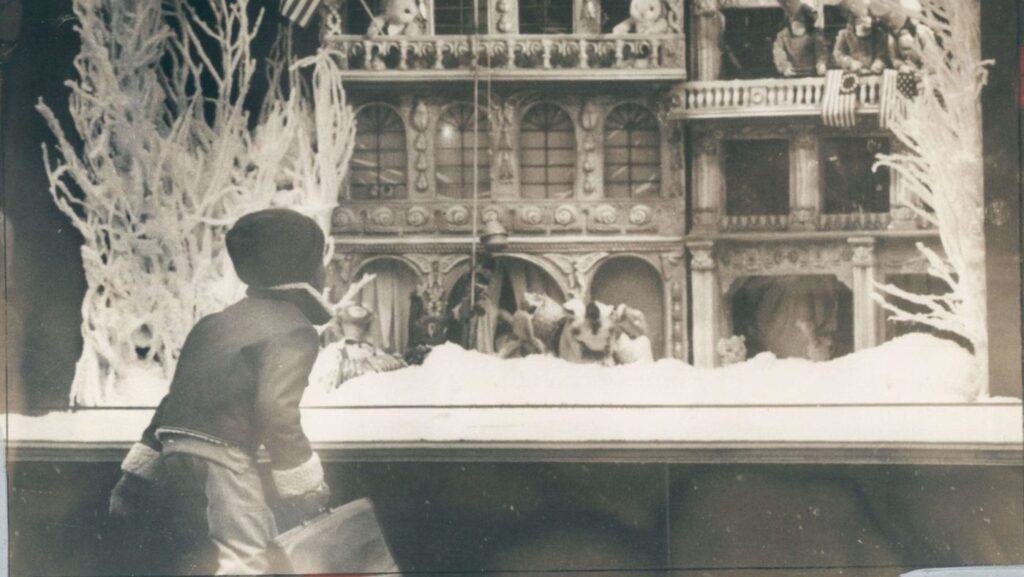Retro: Baltimore loved a Christmas store bargain in the 1950s
- December 19, 2023

The Christmas shoppers assembled inside the front doors of Baltimore’s departments awaiting the sound of the 9:30 a.m. bell. It was like a school, with a sales associate drawing back a rope for the early-bird customers. They shot off to escalators, elevators, and maybe a candy or perfume counter.
Many of these serious shoppers had been downtown for an hour or so. They knew that the lunch counter at the old Read’s drug store was open and why not start the day with a grilled sticky bun studded with nuts and coffee or a whole platter of eggs and bacon?
Christmas shopping involved boarding streetcars and buses in the 1950s. There was excitement to downtown shopping at Hutzler’s, Hochschild Kohn, Hecht’s and Stewart’s. The stores were steps away from one another and provided a kind of retail theater.
Lexington Street met Charles Street and each of those thoroughfares had its own personality. Until 1954, the fine linen and clothing store O’Neill & Co. set a certain tone. But Charles Street also had an array of other carriage trade retailers, while Lexington Street was the place to be for thrifty shopping.
In time, the suburbs overshadowed downtown Baltimore. It was less hassle, if you drove, to pull into a parking space at Belvedere, Towson, Eastpoint, Reisterstown Road, Security Square, Golden Ring, Edmondson Village, Mondawmin, Westview, Columbia and Harundale shopping centers.
The suburban stores were casual. The older downtown stores seemed to appeal to those who liked dressing up to shop and building a day around lunch in their tea rooms and luncheonettes.
The stores had a cuisine of their own. Hochschild’s had a seven-layer dark chocolate cake. Hutzler’s offered cheese toast, chicken chow mein, Wellesley fudge and Lady Baltimore cake. Hecht’s had a courtyard restaurant made up of old Baltimore storefronts salvaged from urban renewal projects. There was even an electrified gas street lamp.
“At Stewart’s, we found there was also a large suburban market,” said Donald Alexander, a former department store buyer, in a 2016 Sun article. “When we opened the York Road location in the Drumcastle shopping center on York Road, it equaled in its first year the sales revenues of the downtown store. It was phenomenally successful. We enlarged that store three times.”
When talking about shopping in the past, the Hess shoe chain is often recalled by Baltimoreans for its glass case of live monkeys at Edmondson Village Center. Eastpoint Mall once had live penguins and at one point in the 1920s the old Bernheimer-Leader store had reindeer in its window.
Hochschild’s had an animated laughing Santa and Hutzler’s Tinsel and Bow, fake reindeer rigged with microphones that caught shoppers cold when the animals spoke. Many stores had animated windows that attracted lookers long after the stores were closed for the night.
Each Baltimore neighborhood had its own mini shopping district, often anchored by a Woolworth’s, a Murphy’s or another five-and-dime store.
Colorful outdoor decorations filled the streets along Pennsylvania Avenue, Highlandtown, Govans, South Broadway, Monument Street, Waverly and South Baltimore-Federal Hill.
Before 1960, the large downtown stores excluded African American customers. There were two downtown department stores — Gutman’s and Brager’s — both a block off Howard Street that did welcome Black customers. The smaller shops along Lexington Street did not turn people down for race and were appropriately busy.
Gutman’s also sought students from the predominantly Black Frederick Douglass High School to work at its Lexington Street store.
About the time that the racial barriers fell, a new type of store arrived, the nationally based cut-price houses: Gem, Topp’s, E.J. Korvette’s, Montgomery Ward and later, Value City.
Baltimore is a city of eccentricities and there was another class of store. The odd places — often much beloved and engendering strong customer loyalty — Ellis of Broadway, John’s Bargain Stores, Shocket’s, C-Mart and Conkling Salvage Exchange and Foam Center.
Shoppers never knew quite what to expect in these shops, and maybe just the curiosity value drew the crowds.
These were smaller operations where the owners delighted in a store closeout in New York City or elsewhere, and then buying and bringing the goods to Baltimore. There were times when a mere rumor of possible Kate Spade handbags or Ralph Lauren Purple Line drew lines to C-Mart all the way in Harford County.
Sign Up For Our
Newsletter
Each day, we honor and remember those who have recently passed away.
Most Viewed
More
- Article Obituaries
- Celebrities
- Celebrity News
- Free Obituary
- Local
- News
- News & Advice
- NFL
- NHL
- Northside
- Norwin
- Obituaries
- Obituary
- Penn Hills
- Pirates
- Pitt
- Pittsburgh
- Plum
- Politics Election
- Premium Memorial
- Sports
- Steelers
- Theater Arts
- Top Stories
- Travel
- Tribune Review Obituaries
- US-World
- Valley News Dispatch
- West End
- Westmoreland
- World